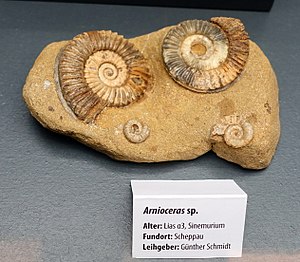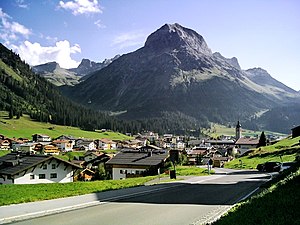Arnioceras
| Arnioceras | ||||||||||||
|---|---|---|---|---|---|---|---|---|---|---|---|---|

Arnioceras acuticarinatum |
||||||||||||
| Temporal occurrence | ||||||||||||
| Sinemurium | ||||||||||||
| 197 to 195 million years | ||||||||||||
| Locations | ||||||||||||
|
||||||||||||
| Systematics | ||||||||||||
|
||||||||||||
| Scientific name | ||||||||||||
| Arnioceras | ||||||||||||
| Hyatt , 1897 | ||||||||||||
Arnioceras is a genus of quite large, evolutionary, disc-shaped ammonites . It occurs as a key fossil in the Sinemurian almost worldwide.
Systematics
The genus Arnioceras belongs to the family of Arietitidae (subfamily Arietitinae ) within the superfamily of Psiloceratoidea . The following taxa are known from her:
- Arnioceras acuticarinatum Simpson
- Arnioceras arnouldi Dumortier, 1867
- Arnioceras bodleyi Buckman, 1844
- Arnioceras ceratitoides Quenstedt, 1848
- Arnioceras crassicosta
- Arnioceras cuneiforme Hyatt, 1867 , type fossil
- Arnioceras densicosta Quenstedt, 1884
- Arnioceras falcaries Quenstedt, 1858
- Arnioceras fieldingiceroides Dommergues and Faure, 1986
- Arnioceras flavum Buckman, 1918 , probably identical to Arnioceras miserabile
- Arnioceras fortunatum Buckman
- Arnioceras geometricum Oppel
- Arnioceras hartmanni
- Arnioceras humboldti Hyatt , identical to Arnioceras ceratitoides
- Arnioceras insolitum Fucini, 1902
- Arnioceras kridioides Hyatt
- Arnioceras laevissimum Quenstedt
- Arnioceras lotharingicum , Fucini, 1902
- Arnioceras mendax Fucini
- Arnioceras miserabile Gabb, 1869
- Arnioceras nevadanum
- Arnioceras nodulosum Buckman
- Arnioceras oppeli Guérin-Franiatte, 1966
- Arnioceras paucicostum Fucini, 1902
- Arnioceras paucicostum Ferretti, 1975
- Arnioceras pluriplicata Fucini , identical to Arnioceras densicosta
- Arnioceras pseudokridion
- Arnioceras rejectum Fucini, 1902
- Arnioceras robustum Quenstedt, 1864
- Arnioceras semicostatoides
- Arnioceras semicostatum Young and Bird, 1828
- Arnioceras sp.
- Arnioceras speciosum Fucini, 1902
- Arnioceras subgeometricum Jaworski
As be sister act Coroniceras , Guexiceras , Longziceras , Metarnioceras , Schreinbachites , Tmaegoceras and Vermiceras .
Synonyms of the genus Arnioceras are:
- Armioceras Spath, 1919
- Arniococeas Arkell, 1951
- Arniotites Whiteaves, 1889
- Burkhardticeras Lopez, 1967
- Eparnioceras Spath, 1924
- Laevispirus Venturi and Nannarone, 2002
- Melanhippites Crickmay, 1928
description
The genus Arnioceras usually reaches a size (diameter D) of several centimeters to a maximum of just over 15 centimeters. The shell of the phragmoconch is regularly rolled up so that all the coils can be seen. The maximum coil height (WH) rarely exceeds 3 centimeters. The winding cross-section is usually rectangular to almost square, sometimes oval or rounded. The diameter of the umbilical region (UD) makes up between 45 and 60% (U) of the total diameter. The navel is smooth up to a diameter of 1.5 centimeters. The mostly flat flanks have strong and distinct, quite close-fitting ribs, which run in a straight line and only bend forward when the ventral margin is reached and hit the side keels or slowly run out (as in A. miserabile and A. laevissimum ). The venter carries a keel, which is accompanied in most types of furrows (sulci) and lateral keels. The line of praise is quite simple and similar to Ceratiten with deeply cut side lobes.
Ammonite zone and key fossil
Taxa of the genus Arnioceras are index fossils in several bio-horizons of the lower Sinemurian. The semicostatum zone , named after Arnioceras semicostatum , is the second ammonite zone of the Sinemurium. It follows the Bucklandi zone and is in turn overlaid by the Turneri zone of the lower Sinemurian. Taxa of the genus Arnioceras occur mainly in the semicostatum zone, but Arnioceras hartmanni still forms a horizon in the Turneri zone and late forms of Arnioceras such as Arnioceras semicostatoides can even be found in the obtusum zone of the upper sinemurium ( Lotharingium ).
The semicostatum zone is subdivided as follows (from hanging wall to lying ):
- Sauzeanum subzone
- Sauzeanum Biozone
- Horizon from Arnioceras semicostatum
- Horizon from Pararnioceras alcinoeiforme
- Horizon Euagassiceras sp.
- Horizon of Euagassiceras resupinatum
- Sauzeanum Biozone
- Scipionanum subzone
- Nodulatum biozone
- Horizon from Arnioceras pseudokridion
- Scipionanum Biozone
- Horizon of Arnioceras acuticarinatum
- Nodulatum biozone
- Lyra subzone
- Alcinoe Biozone
- Horizon Pararnioceras alcinoe
- Crossi biozone
- Horizon Paracoroniceras sp.
- Horizon from Arnioceras bodleyi
- Charlesi Biozone
- Horizon of Paracoroniceras charlesi
- Lyra biozone
- Horizon of Paracoroniceras lyra
- Alcinoe Biozone
The Semicostatum zone thus consists of eleven horizons, four of which contain taxa of the genus Arnioceras as key fossils.
Occurrence
The genus Arnioceras was a cosmopolitan with almost worldwide distribution, which populated the oceans over a considerable part of the Sinemurian. In north-western Europe it can be found from the hanging wall of the Bucklandi zone to the lower obtusum zone; in North America this corresponds to the period from the upper involutum zone to the lower carinatum zone.
Occurrences of the genus Arnioceras in Germany can be found in Bebenhausen near Tübingen , in Blumberg- Achdorf an der Wutach , near Hüfingen- Behla near Donaueschingen , near Mundelfingen on the Swabian Alb and near Schwäbisch Gmünd in Baden-Württemberg as well as near Bielefeld and on the Scheppau near Bornum am Elm in North Rhine-Westphalia .
For Austria , the quarries around Adnet and Glasenbach southeast of Salzburg are to be mentioned, but also the Allgäu layers on the Omeshorn (2557 m) near Lech in Vorarlberg .
In Switzerland , in addition to Frick in the canton of Aargau , the references in the Lias of the Helvetic at Ferdenrothorn ( Canton of Valais ) and in the Glarus Alps important Other sites are located on the Grammont in Valais and north of Jaun in the canton of Friborg .
In Luxembourg , the genus Arnioceras occurs in Bertrange and even in the city of Luxembourg near Hollerich . The deposits continue in the south of Belgium , namely at Arlon , Orval and Virton ( province of Luxembourg ). The Jura in France also has the genus Arnioceras , especially in the area around Montbéliard , at Salins-les-Bains ( Jura department ), at Semur-en-Auxois and at Beaune in Burgundy ( Côte-d'Or ). Separated from this are the Jura occurrences in the western Alps in the Oisans (find sites Chalet-Voyron and Rif-Tor in the Isère department ), which also have Arnioceras .
Sites of the genus Arnioceras in Italy are in the central Apennines , on Monte Cetona and near Longi in Sicily . In England , finds have been made at Bishop's Cleeve in Gloucestershire , near Robin Hood's Bay in Yorkshire , Shepton Mallet in the Mendip Hills , Ilchester , Horton , Taunton (all in Somerset ) and the Blue Lias of Dorset . In the Blue Lias of Glamorgan in Wales there are also fossils of the genus Arnioceras . In the Eastern Carpathians of Romania , the genus Arnioceras is found on the Praşca mountain .
Outside of Europe, the genus Arnioceras appears in North America , for example in the Antimonio Formation in the state of Sonora in Mexico , in British Columbia ( Canada ) on the Queen Charlotte Archipelago and in the Last Creek Formation , in the Talkeetna Formation in Alaska , in the Sunrise Formation of the Gabbs Valley Range and in the Shoshone Mountains in Nevada ( United States ). In South America , the occurrences near Mendoza in Argentina and in the south of the Antofagasta province of Chile are worth mentioning.
In the Tethys area, mention should be made of the pelagic limestone of the Ouarka Formation in northeast Algeria , the Oust Formation in Tunisia and the deposits on Roti and Timor . The genus Arnioceras can even be found in New Caledonia (northwest of Nouméa in the Téremba unit and in the Nouméa-Dumbéa unit ) and also in New Zealand .
literature
- WJ Arkell et al .: Mesozoic Ammonoidea. Treatise on Invertebrate Paleontology. Geological Society of America and University of Kansas Press, 1957.
- Simone Guérin-Franiatte: Ammonites Du Lias Inférieur de France. Psiloceratidae: Arietitidae . Ed .: Center National de la Recherche Scientifique. Paris 1966, p. 455 .
- E. Jaworski: About Arnioceras geometricum OPPEL and related species; together with an appendix on Ammonites natrix SCHLOTHEIM, 1820 . In: New Yearbook For Mineralogy, Geology and Paleontology . tape 65 , 1931, pp. 83-1401 .
Individual evidence
- ↑ JJ Sepkoski: A compendium of fossil marine animal genera . In: Bulletins of American Paleontology . tape 363 , 2002, p. 1-560 .
- ↑ M. Gruner: Dynamic paleoecology and taxonomic treatment of the Lower Jurassic (Hettangian to Lower Sinemurian) on the Swabian Alb . In: Profile . tape 11 . Stuttgart 1997, p. 1-197 .
- ↑ Jean-Louis Dommergues, Christian masters and Florian Böhm: New Data on Austroalpine Liassic Ammonites from the Adnet Quarries and Adjacent Areas (Upper Austria, Northern Calcareous Alps) . In: Yearbook of the Federal Geological Institute . 138 issue 2. Vienna 1995, p. 161-205 .
- ^ Christian Meister: Biostratigraphie des ammonites liasiques des Alpes de Glaris: comparaisons et corrélations avec la régon du Ferdenrothorn (Valais) . In: Eclogae geol. Helv. Band 84/1 , 1991, pp. 223-243 .
- ↑ Robert Colbach, Simone Guerin Franiatte and Robert Maquil: Un remarquable site fossilifère dans le Sinémurien inférieur de Bertrange (Grand Duchy of Luxembourg) . In: Ferrantia . tape 36 , 2003, p. 53-64 .
- ↑ Michael J. Simms: The Lower Lias of northern Gloucestershire: New data on Early Jurassic stratigraphy and outcrop patterns from temporary exposures . In: Proceedings of the Cotteswold Naturalists' Field Club . 2003, p. 191-205 .
- ^ A. Hallam: A sedimentary and faunal study of the Blue Lias of Dorset and Glamorgan . In: Philosophical Transactions of the Royal Society . tape 243 . London 1960, p. 1-44 .
- ^ J. Pálfy, PL Smith, JK Mortensen and RM Friedman: Integrated ammonite biochronology and U-Pb geochronometry from a basal Jurassic section in Alaska . In: Geological Society America Bulletin . tape 111 , no. 10 , 1999, p. 1537-1549 .
- ^ Pengfei Hou: Sinemurian (Early Jurassic) Stratigraphy at Last Creek, British Columbia and Five Card Draw, Nevada: Paleontology and Environmental Implications . In: Diploma thesis . Vancouver 2014.
- ↑ AC Riccardi, SE Damborenea, MO Mancenido and SC Ballent: Hettangian and Sinemurian (Lower Jurassic) biostratigraphy of Argentina . In: Journal of South American Earth Sciences . tape 4 , no. 3 , 1991, pp. 159-170 .
- ↑ Milos Rakús and Jean Guex: Les ammonites du jurassique inférieur et moyen de la dorsale tunisienne . In: Mémoires de Géologie (Lausanne) . tape 39 , 2002, p. 1-149 .
- ↑ Christian master, Pierre Maurizot and Jack A. Grant-Mackie: Early Jurassic (Hettang ian-Sinemurian) ammonites from New Caledonia (French Overseas Territory, Western Pacific) . In: Paleontological Research . Vol. 14, No. 2 , 2010, p. 85-118 , doi : 10.2517 / 1342-8144-14.2.085 .

